Rotary dial
A rotary dial is a component of a telephone or a telephone switchboard that implements a signaling technology in telecommunications known as pulse dialing. It is used when initiating a telephone call to transmit the destination telephone number to a telephone exchange.
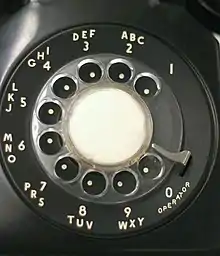
On the rotary phone dial, the digits are arranged in a circular layout so that a finger wheel may be rotated against spring tension with one finger. Starting from the position of each digit and rotating to the fixed finger stop position, the angle through which the dial is rotated corresponds to the desired digit. Compact telephones with the dial in the handset had all holes equally spaced in the dial, and a spring-loaded finger stop with limited travel.
When released at the finger stop, the wheel returns to its home position driven by the spring at a speed regulated by a centrifugal governor device. During this return rotation, the dial interrupts the direct electrical current of the telephone line (local loop) the specific number of times associated with each digit and thereby generates electrical pulses which the telephone exchange decodes into each dialed digit. Each of the ten digits is encoded in sequences to correspond to the number of pulses, so the method is sometimes called decadic dialing.
Dial pulsing contacts are normally closed, in series with the rest of the circuit components. Pulses briefly open the contacts for roughly 50 milliseconds. The earphone is disconnected by the dial mechanism when dialing to prevent very loud clicking from being heard in the earphone. Slow-release relays in the central office keep the phone from being disconnected by dial pulses.
The first patent for a rotary dial was granted to Almon Brown Strowger (November 29, 1892) as U.S. Patent 486,909, but the commonly known form with holes in the finger wheel was not introduced until about 1904. While used in telephone systems of the independent telephone companies, rotary dial service in the Bell System in the United States was not common until the introduction of the Western Electric model 50AL in 1919.[1]
From the 1970s onward, the rotary dial was gradually supplanted by DTMF (dual-tone multi-frequency) push-button dialing, first introduced to the public at the 1962 World's Fair under the trade name "Touch-Tone". Touch-tone technology primarily used a keypad in the form of a rectangular array of push-buttons. Although no longer in common use, the rotary dial's legacy remains in the verb "to dial (a telephone number)".
History
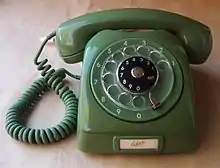

From as early as 1836 onward, various suggestions and inventions of dials for sending telegraph signals were reported. After the first commercial telephone exchange was installed in 1878, the need for an automated, user-controlled method of directing a telephone call became apparent. Addressing the technical shortcomings, Almon Brown Strowger invented a telephone dial in 1891.[2] Before 1891, numerous competing inventions, and 26 patents for dials, push-buttons, and similar mechanisms, specified methods of signalling a destination telephone station that a subscriber wanted to call. Most inventions involved costly, intricate mechanisms and required the user to perform complex manipulations.
The first commercial installation of a telephone dial accompanied the first commercial installation of a 99-line automatic telephone exchange in La Porte, Indiana, in 1892, which was based on the 1891 Strowger designs. The original dials required complex operational sequences. A workable, albeit error-prone, system was invented by the Automatic Electric Company using three push-buttons on the telephone. These buttons represented the hundreds, tens, and single units of a telephone number. When calling the subscriber number 163, for example, the user had to push the hundreds button once, followed by six presses of the tens button, and three presses of the units button.[3] In 1896, this system was supplanted by an automatic contact-making machine, or calling device. Further development continued during the 1890s and the early 1900s in conjunction with improvements in switching technology.
Almon Brown Strowger was the first to file a patent for a rotary dial on December 21, 1891, which was awarded on November 29, 1892, as U.S. Patent 486,909.[4][5] The early rotary dials used lugs on a finger plate instead of holes, and the pulse train was generated without the control of spring action or a governor on the forward movement of the wheel, which proved to be difficult to operate correctly.
On rotary dial phones smaller numbers, such as 2, are dialed more rapidly than longer numbers, such as 9 (because the dial turns much further with a 9). In 1947, area codes were introduced in the United States, so as to facilitate direct distance dialing first by operators, then by subscribers. In the original system in use until 1995, the first digit of the area code could not be a one or a zero, but the second number had to be a one or zero. This allowed mechanical switching equipment in the central offices to distinguish local from "long distance" calls, since one and zero have no associated letters that could spell out telephone exchange names.
Therefore, the lowest and most quickly dialed code was 212; the highest and slowest 909. The Bell System, in developing the original area codes, assigned the lowest codes to the areas where they would be most used: the large cities. 212, the lowest number, was New York City. The next to lowest, 213 and 312, were Los Angeles and Chicago. 214 was Dallas, 313 Detroit, and 412 was Pittsburgh. A high number like 919 was assigned to North Carolina. An even higher number, 907 (higher because the 0 counts as 10), was Alaska.
In the 1950s, plastic materials were introduced in dial construction, replacing metal which was heavier and subject to higher wear.
Despite their lack of modern features, rotary phones occasionally find special uses. For instance, the anti-drug Fairlawn Coalition of the Anacostia section of Washington, D.C., persuaded the phone company to reinstall rotary-dial pay phones in the 1980s to discourage loitering by drug purchasers, since they lacked a telephone keypad to leave messages on dealers' pagers.[6] They are also retained for authenticity in historic properties such as the U.S. Route 66 Blue Swallow Motel, which date back to the era of named exchanges and pulse dialing.[7]
Construction
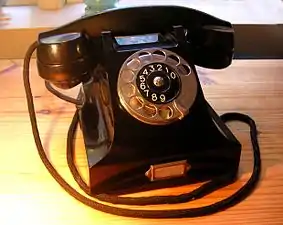
A rotary dial typically features a circular construction. The shaft that actuates the mechanical switching mechanism is driven by the finger wheel, a disk that has ten finger holes aligned close to the circumference. The finger wheel may be transparent or opaque permitting the viewing of the face plate, or number plate below, either in whole, or only showing the number assignment for each finger hole. The faceplate is printed with numbers, and sometimes letters, corresponding to each finger hole. The 1 is normally set at approximately 60 degrees clockwise from the uppermost point of the dial, or approximately at the 2 o'clock position, and then the numbers progress counterclockwise, with the 0 being at about 5 o'clock. A curved device called a finger stop sits above the dial at approximately the 4 o'clock position. The physical nature of the dialing mechanism on rotary phones allowed the use of physical locking mechanisms to prevent unauthorized use. The lock could be integral to the phone itself or a separate device inserted through the finger hole nearest the finger stop to prevent the dial from rotating.
Principal dial mechanisms in the United States
In the USA. there were two principal dial mechanisms, the more common being Western Electric for the Bell System, the other being made by Automatic Electric.
The Western Electric dial had spur gears to power the governor, so the governor and dial shafts were parallel.
The Automatic Electric governor shaft was parallel to the plane of the dial. Its shaft had worm gearing in which, very atypically, the gear drove the worm. The worm, highly polished, had extreme pitch, its teeth at about 45° to its axis. This was the same as the gearing for the speed-limiting fan in traditional music boxes.
The Western Electric governor was a cup surrounding spring-loaded pivoted weights with friction pads. The Automatic Electric governor had weights on the middles of curved springs made from strip stock. When it speeded up after the dial was released, the weights moved outward, pulling the ends of their springs together. Springs were fixed to a collar on the shaft at one end, and to the hub of a sliding brake disc at the other end. At speed, the brake disc contacted a friction pad. This governor was similar to that in spring-driven windup phonograph turntables of the early 20th century.
Both types had wrap-spring clutches for driving their governors. When winding the dial-return spring, these clutches disconnected to let the dial turn quickly. When the dial was released, the clutch spring wrapped tightly to drive the governor.
While winding the dial, a spring-centered pawl in the Western Electric dial wiggled off-center when driven by the cam on the dial shaft. Teeth on that cam were spaced apart by the same angle as dial hole spacing. During winding, the pawl moved off-center away from the normally-closed pulsing contacts. When the dial was released, the cam teeth moved the pawl the other way to open and release the dial contacts.
In the Automatic Electric dial, the pulsing cam and governor were driven by a wrap-spring clutch as the dial returned. When winding, that clutch disconnected both cam and governor.
When winding a Western Electric dial, one could feel the pawl being moved by the cam, although the feel was subtle. Winding an Automatic Electric dial, however, felt extremely smooth.
Letters
In addition to the numbers, the faceplate is often printed with letters corresponding to each finger hole.

In North America, traditional dials have letter codes displayed with the numbers under the finger holes in the following pattern: 1, 2 ABC, 3 DEF, 4 GHI, 5 JKL, 6 MNO, 7 PRS, 8 TUV, 9 WXY, and 0 (sometimes Z) Operator. Letters were associated with the dial numbers to represent telephone exchange names in communities having more than 9,999 telephone lines, and additionally given a meaningful mnemonic to facilitate memorization of individual telephone numbers by incorporating their exchange names. For example: "RE7-xxxx" represented "REgent 7-xxxx", 'Regent' being a local exchange name used in Canada, derived from an earlier precursor telephone number, '7xxxx' –with callers actually dialing '73-7xxxx' (737-xxxx).
The use of letters on dials was proposed in 1917 by W. G. Blauvelt of AT&T. Large cities like New York would ultimately require a seven-digit number, but some tests in the early 1900s indicated that the short-term memory span of many people could not handle seven digits and many dialling errors due to memory lapse might occur (the documentation for these tests is lost). Hence the first Panel automatic exchanges cutover in 1915 in Newark, New Jersey used "semiautomatic" operation with the local operator keying the number for the caller. And as large cities would have both manual and automatic exchanges for some years, the numbers for manual or automatic exchanges would have the same format (originally MULberry 3456, with three letters then four numbers), which could be either spoken or dialled. [8]
Since the late 1940s, telephones were redesigned with the numbers and letters on a ring outside the finger wheel to provide better visibility.[9]
Britain

In the United Kingdom the letter "O" was combined with the digit "0" rather than "6". In large cities the seven-digit numbers comprised three letters for the exchange name, followed by four numbers.
Australia
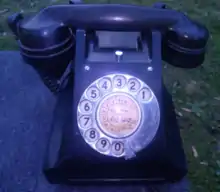
Before 1960 Australian rotary dial telephones had each number's corresponding letter printed on a paper disc in the centre of the plate, with space where the subscriber could add the phone number. The paper was protected by a clear plastic disc, held in place by a form of retaining ring which also served to locate the disc radially. The Australian letter-to-number mapping was A=1, B=2, F=3, J=4, L=5, M=6, U=7, W=8, X=9, Y=0, so the phone number BX 3701 was in fact 29 3701. When Australia around 1960 changed to all-numeric telephone dials, a mnemonic to help people associate letters with numbers was the sentence, "All Big Fish Jump Like Mad Under Water eXcept Yabbies."
Eastern bloc
Alphabetic designation of exchanges with Cyrillic letters (А, Б, В, Г, Д, Е, Ж, И, К, Л for each of the digits from 1 through 0 respectively) was also used for a short period in the Soviet Union in the 1950s and 1960s, but by the next decade this practice was largely discontinued.[10][11]
However, such letter codes were not used in all countries.
Function
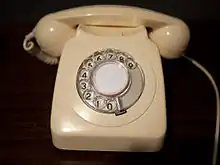
To dial a number, the user puts a finger in the corresponding finger hole and rotates the dial clockwise until it reaches the finger stop. The user then pulls out the finger, and a spring in the dial returns it to the resting position. For example, if the user dials "6" on a North American phone, electrical contacts operated by a cam on the dial shaft and a pawl will open and close six times as the dial returns to home position, thus sending six pulses to the central office. British and Australian dials work the same way.
Different pulse systems are used, varying from country to country. For example, Sweden uses one pulse to signal the number zero, and 10 pulses to signal the number nine. New Zealand uses ten pulses minus the number desired; so dialing 7 produces three pulses. In Norway, the North American system with the number '1' corresponding to one pulse was used, except for the capital, Oslo, which used the same "inverse" system as in New Zealand.
For this reason, the numbers on the dial are shifted in different countries, or even in different areas of one country, to work with their system because of the difference of the number arrangement on the dial. The dial numbering can occur in four different formats, with 0 adjacent either to the 1 or the 9, and the numbers running in ascending or descending order, with either the 0, 1 or 9 being closest to the finger stop.
Rotary dial telephones have no redial feature; the complete number must be dialed for every attempted call.
Emergency calling
A relic of these differences is found in emergency telephone numbers used in various countries; the United Kingdom selected 999 due to the ease of converting call office dials to make free calls. "0" for the Operator was already free, and the cam that removed the shunt on the line when the dial was rotated to the "0" position could be altered to include the adjacent digit "9" (and "8" if required) so that calls to "0" and "999" could be made without inserting coins. In New Zealand, 111 was selected because New Zealand reverse-numbered dials make each digit "1" send 9 pulses to the central office/telephone exchange (like "9" in Britain), allowing British exchange equipment to be used off the shelf.
Recoil spring
Early dials worked by direct or forward action. The pulses were generated as the dial turned toward the finger stop position. When the user's hand motion was erratic, it produced the wrong numbers. In the late 19th century, the dial was refined to operate automatically by a recoil spring. The user selected the digit to be dialed, rotated the dial to the finger stop, then released it. The spring caused the dial to rotate back to its home position during which time constant speed was maintained with a centrifugal governor.
Dials at user stations typically produced pulses at the rate of ten pulses per second (pps), while dials on operator consoles on Crossbar or electronic exchanges often pulsed at 20 pps.
The rotary dial governor is subject to wear and aging, and may require periodic cleaning, lubrication and adjustment by a telephone technician. In the video, the green LED shows the dial impulse pulses and the red LED shows the dial's off-normal contact function.
Off-normal contacts typically serve two additional functions. They may implement a shunt across the transmitter circuit and induction coil to maximize the pulsing signal of the dial by eliminating all internal impedances of the telephone set. Another function is to short-circuit the telephone receiver during dialing, to prevent audible clicking noise from being heard by the telephone user.
Dials within handsets

Some telephones include a small dial built into the handset, with a movable finger stop. The user rotates the dial clockwise until the finger stop ceases moving, then releases both. In this design the holes extend around the full circumference of the dial, allowing a reduced diameter. This was introduced by Western Electric on the compact Trimline telephone, the first to locate the dial in the handset. In Spain, such phones were manufactured for CTNE (Compañía Telefónica Nacional de España) by Málaga-based factory "CITESA", being named as "Góndola" phones by its particular shape. Spanish Góndola sets were fitted from the beginning with a red LED series connected with the line, allowing the dial ("disco" in Spanish) to be backlit while dialling. For that, the LED was bridged by an anti-parallel Zener diode, to allow the DC to pass even if the line polarity were reversed. In case of line polarity reversal, the LED would not light, but the phone would work anyway. The LED and Zener diode were contained in the same package for ease of assembly in manufacturing.
Push-button pulse phones
In the UK, some early phones (in the mid to late 1960s) were built which continued to provide the same rotary-dial signalling on their PABX by using a separate converter to give 10-PPS, but were operated with buttons. Some of these, such as the GPO 726 or 728 can be distinguished from touch-tone phones by the lack of * and # keys and unusual key layout.[12]
Later so-called "Self-Contained" (SC) Keyphones used a line-powered electronic circuit within the phone to convert the keyed-in digits to give 10-PPS that was required to work on normal Strowger, Crossbar or Electronic public exchanges. They are GPO (BT) type 756 (no-battery), 1/764 & 2/764 or 765 (with NiCD batteries), or 766 (no-battery) to name a few. These also do not have the * or # keys.
See also
- AIOD leads (automatic identified outward dialing)
- Crossbar switch
- Dial tone
- Direct distance dialing (DDD)
- History of the telephone
- Single-frequency signaling
- Stepping switch
- Title 47 CFR Part 68
References
- Roberts, William Lee. "A look at the evolution of the Dial Telephone". Retrieved 15 January 2016.
- Fiber Optics Weekly Update. Information Gatekeepers Inc.
- Smith, A. B.; Campbell, W. L., Automatic Telephony, New York, McGraw-Hill, 1921, p. 38.
- Greenman, Catherine (October 7, 1999). "When Dials Were Round and Clicks Were Plentiful". The New York Times. Archived from the original on 2007-06-16 – via oldphones.com.
- "Automatic Telephone or Other Electrical Exchange". United States Patent and Trademark Office.
- Benson, Bruce L. (1998). "Private Justice in America". To Serve and Protect: Privatization and Community in Criminal Justice. pp. 123–124. ISBN 0-8147-1327-0.
- John Flinn (October 5, 2012). "Route 66 still has some kicks". San Francisco Chronicle. Retrieved 2012-10-08.
- A History of Engineering and Science in the Bell System: The Early Years (1875-1925) p578 by M. D. Fagen (editor) & Bell Labs technical staff (1975, Bell Telephone Laboratories)
- Vanderbilt, Tom (2012-05-15). "Hello?". Slate. ISSN 1091-2339. Retrieved 2017-02-04.
- History of Moscow City Telephone Network Archived 2014-07-09 at archive.today (in Russian)
- A short history of telephone numbers, includes a copy of the 1968 flyer about abolishing letters in Moscow telephone numbers from the museum of Moscow City Telephone Network
- "TELEPHONE No. 728". www.britishtelephones.com. Retrieved May 6, 2017.
External links
- "The Invention and Development of the Dial Telphone: The Contribution of Three Lindsborg Inventors" by Emory Lindquist; Spring 1957 issue of The Kansas Historical Quarterly
- "How Your Dial Phone Works", Popular Science, August 1946—detailed article on subject with illustrations
- AT&T Archives Director's Cut - Now You Can Dial (YouTube), from the AT&T archives